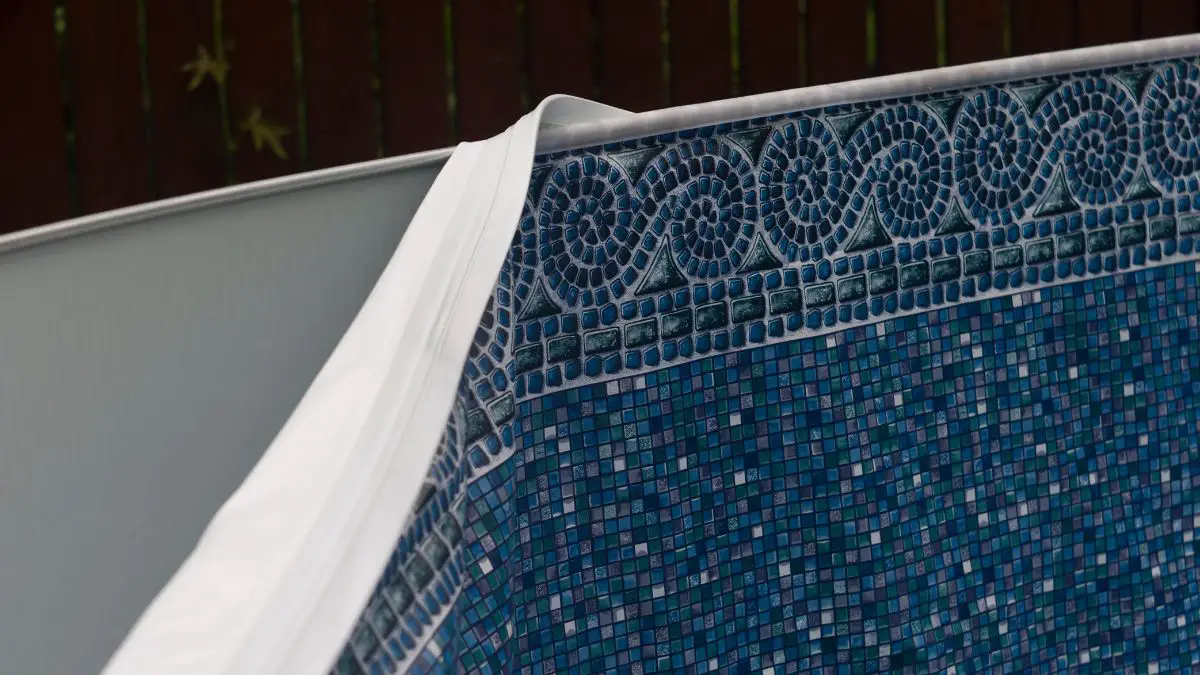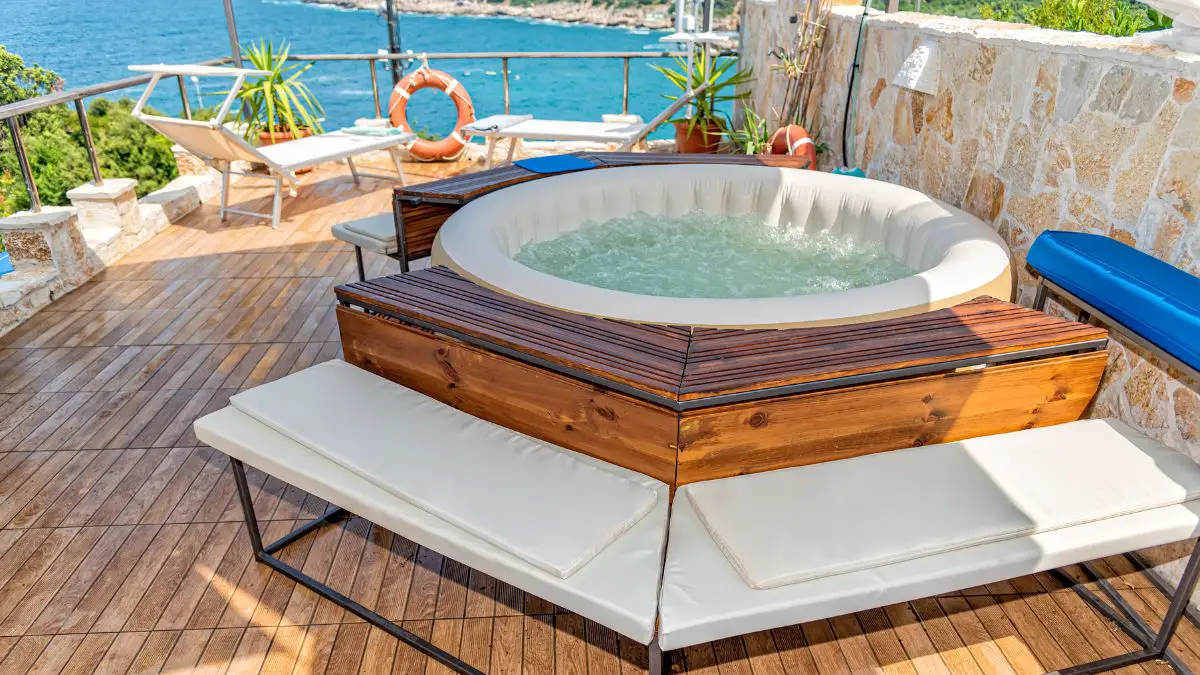Cleaning your pool liner depends on the type of liner you have. Here are the steps for cleaning different types of pool liners or surfaces:
How to Clean a Vinyl Pool Liner
- Remove Debris: Use a leaf net to remove any debris, like leaves, from the pool as soon as possible to prevent stains.
- Brush the Liner: Use a soft-bristle brush or sponge to gently brush the liner at least once a week to prevent dirt, debris, and undissolved chemicals from accumulating.
- Use the Right Cleaning Products: Use a product specifically for pool liners. Avoid household cleaners and be careful with chlorine, as it can bleach away your pool liner pattern if concentrated. White vinegar, baking soda, or organic dish soap can be used for mildew and stains.
- Maintain Proper Water Chemistry: Regularly test your water chemistry. Proper water chemistry will help prevent algae and other debris that can stain and damage your liner.
- Professional Cleaning: Get the pool cleaned professionally at least once a year.
How to Clean Fiberglass Pool Surface
- Remove Debris: Don’t let leaves or dirt sit on your pool steps.
- Use the Right Cleaning Products: Use a non-phosphate detergent, such as the Magic Eraser, to clean the liner.
- Maintain Proper Water Chemistry: Regularly test your water chemistry.
- Professional Cleaning: If none of these methods fade the stain, you can always call a pool servicer to lend their expertise and help you plan your next step.
How to Clean a Concrete Pool Surface
- Remove Debris: Regularly remove any debris from the pool.
- Use the Right Cleaning Products: Use a mild degreasing dish soap mixed with warm water for cleaning.
- Maintain Proper Water Chemistry: Regularly test your water chemistry.
- Professional Cleaning: If the stains persist, consider getting professional help.
Avoid draining the pool for cleaning, as this can cause cracking in the pool’s shell and prompt the liner to wrinkle or become damaged.

Understanding Pool Liners: Your Pool’s Protective Shield
When you think about your swimming pool, what comes to mind? Perhaps it’s the cool, refreshing water or the fun and relaxation it provides. But have you ever stopped to consider the unsung hero of your pool—the pool liner?
A pool liner is like a protective shield for your pool. It’s the layer separating the pool structure from the water, providing swimmers with a smooth and comfortable surface. But that’s not all. Your pool liner also plays a vital role in maintaining your pool’s overall health and longevity.
Various types of pool liners are available, each with its own advantages. Let’s take a closer look:
- Vinyl Pool Liners: These are popular due to their affordability and flexibility. Vinyl liners are easy to install and can be custom-fitted to any pool shape or size. However, vinyl pool liner cleaning requires special care to avoid damage.
- Concrete Pool Liners: Known for their durability, they are a common choice for in-ground pools. They can be painted or finished with plaster, tile, or aggregate for a customized look.
- Fiberglass Pool Liners: These liners are praised for their low maintenance needs. Fiberglass is a nonporous material, which means fewer algae problems and less frequent cleaning.
- Tile Pool Liners: Offering a high-end, luxurious look, tile liners are often used in upscale pool designs. They require more maintenance but can last a long time with proper care.
The role of a pool liner in a swimming pool extends beyond just providing a barrier between the water and the pool structure. It also contributes to the overall aesthetics of your pool. A clean, well-maintained pool liner can enhance the look of your pool, making it more inviting.
Certain types of liners, such as vinyl, can react with pool chemicals, leading to discoloration or damage.
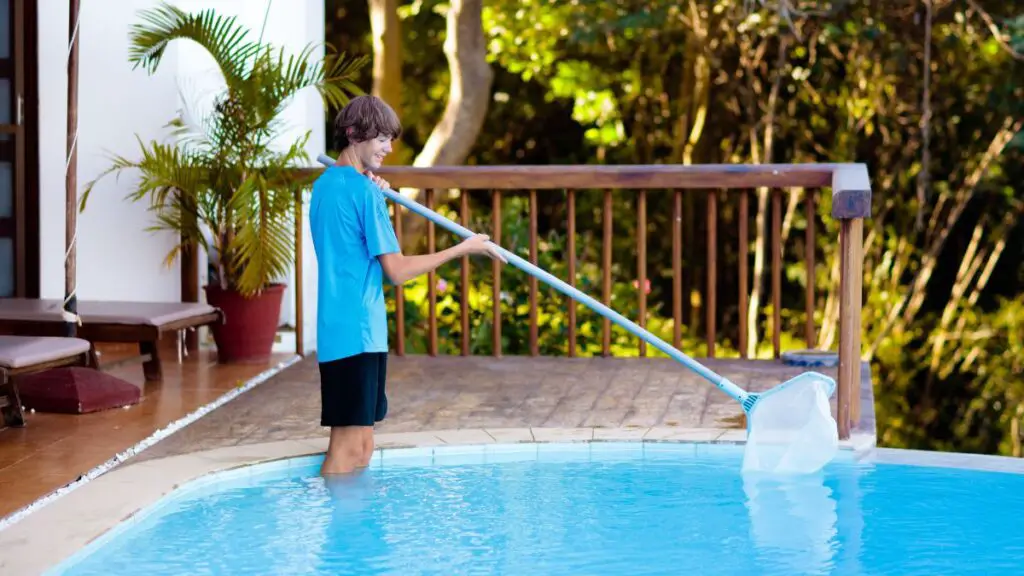
The Importance of a Clean Pool Liner: More Than Just Aesthetics
Pool Health and Safety
Firstly, let’s talk about the impact of a dirty pool liner on pool health. A neglected pool liner can become a breeding ground for algae and bacteria, affecting the quality of your pool water. Algae on pool liners look unsightly and can make the pool surface slippery, posing a safety risk.
Moreover, dirt and debris on the pool liner can interfere with the pool’s filtration system, leading to cloudy water and potentially costly repairs. Regular pool liner cleaning can help prevent these issues, ensuring your pool remains safe and enjoyable.
Aesthetics and Comfort
Now, let’s not forget about the aesthetic importance of a clean pool liner. A clean, well-maintained pool liner is visually appealing and can enhance the overall look of your pool. Whether hosting a pool party or enjoying a quiet swim, a clean pool liner can significantly improve your swimming experience.
Additionally, a clean pool liner is more comfortable for swimmers. No one likes to feel slimy algae or rough dirt under their feet while swimming. Regular pool liner maintenance can ensure a smooth and comfortable surface for everyone to enjoy.
How to Clean Pool Liner in 5 Steps
Keeping your pool liner clean is an essential part of pool maintenance. But how exactly do you go about it?
1: Brushing the Liner
Start by grabbing your pool liner brush. This tool is your first defense against dirt, grime, and algae on pool liners. Brushing with a soft-bristle brush, the liner helps loosen any buildup, making removing it easier.
Here’s how to do it
- Begin at the top of the pool liner and work your way down, brushing in a downward motion.
- Pay special attention to corners and crevices where algae and dirt can accumulate.
- Be gentle to avoid causing damage to the liner.
2: Wiping the Liner
Here’s how to do it
- Dip a clean cloth in the pool water and wring it out.
- Wipe the liner gently, starting from the top and working your way down.
- Rinse the cloth frequently to avoid spreading dirt around.
3: Vacuuming the Liner
After brushing and wiping, you’ll likely have some debris floating in your pool. That’s where your pool liner vacuum comes in. Vacuuming helps to remove any debris that has been dislodged from the liner.
Here’s how to do it
- Attach the vacuum head to the tele-pole and connect the vacuum hose.
- Submerge the vacuum head in the pool, ensuring it’s flat against the liner.
- Move the vacuum slowly across the liner, making sure not to miss any spots.
4: Using Natural Cleaners
Vinegar and baking soda can be effective pool liner cleaning solutions for those who prefer a more natural approach. They’re safe, affordable, and easy to use.
Here’s how to do it
- Mix equal parts vinegar and water in a spray bottle.
- Spray the solution onto the pool liner and let it sit for a few minutes.
- Scrub the liner gently with a brush, then rinse with clean water.
- For tougher stains, make a paste of baking soda and water and apply it to the stain. Let it sit for a few minutes, then scrub and rinse.
5: Using Chemical Cleaners
Sometimes, stubborn stains require a bit more firepower. That’s where chemical cleaners come in. However, using these products cautiously is important to avoid damaging your pool liner.
Here’s how to do it
- Choose a cleaner that’s specifically designed for pool liners. Avoid products that contain harsh abrasives or acids.
- Follow the manufacturer’s instructions carefully. This usually involves applying the cleaner to the liner, letting it sit, then scrubbing and rinsing.
- Always wear protective gear, like gloves and goggles, when using chemical cleaners.
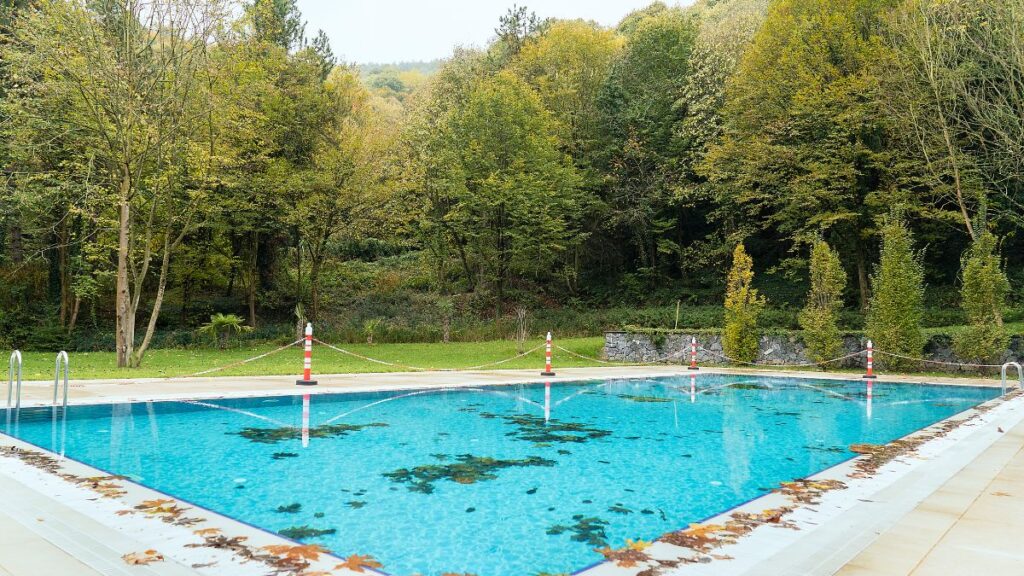
Removing Stains from Pool Liner Without Draining: A Detailed Guide
Removing stains from your pool liner without draining the water can be tricky. The methods used depend on the type of stain and its cause. Here’s a comprehensive guide on how to tackle different types of stains.
Dealing with Organic Stains
Organic stains, typically greenish or brownish, are caused by organic matter like mud, bugs, leaves, or algae. To identify an organic stain, hold a chlorine tablet on the stain. If it disappears, it’s an organic stain.
Removing Algae Stains from Vinyl Pool Liner
Here’s how to get rid of algae stains on a vinyl liner without draining the pool:
- Brush the pool and add enough chlorine to raise the free chlorine (FC) near the shock level.
- Run the pump 24/7 after adding the chlorine.
- Brush the pool frequently to continue loosening any organic matter.
- Once the stains are gone, return the pump back to its normal schedule and allow chlorine levels to fall back to their normal range.
Tackling Metal Stains
Metal stains are harder to clean than organic ones and their color varies depending on the metal causing them. Metals can enter the pool depending on the source of fill water used. Here are some visual cues that can help you determine which metal is causing your stain:
- Iron: reddish-brown color
- Copper: Bluish-green color
- Manganese: Blackish-purple color
You can also determine if the stain is metal-based by rubbing a vitamin C tablet on a stained portion of the liner. If the stain is metal, it should either disappear or change color. Additionally, you can test the water with a metal test kit to better confirm the metal type.
Removing Metal Stains from Vinyl Pool Liner
Most metal stains can be removed through acid. Commercial products exist, but common household acids can also be used.
For smaller areas of staining, you can spot treat as follows:
- Place crushed ascorbic acid (Vitamin C) in a sock.
- Tie a loose knot at the top of the sock.
- Rub the sock around the stain until it disappears.
For larger stains that cover the liner, the following steps can be used:
- Lower the pool’s chlorine to 0 ppm using Sodium Thiosulfate or naturally.
- Optionally, add algaecide to prevent algae.
- Add one of the following acids by pouring around the edge of the pool:
- Ascorbic Acid: ½ pound per 10,000 gallons
- Citric Acid: 1 pound per 10,000 gallons
- Commercial Metal Stain Remover: Dosage per instructions
- Run the pump for an hour to circulate acids.
- Repeat acid addition if stains persist.
- Add a metal sequestrant.
- Run pump continuously, then return to normal schedule.
- Adjust pH to 7.2 and restore normal chlorine levels.
- Monitor for stains and add more sequestrants if needed.
Removing Manganese Stains from Your Pool
Manganese stains can be particularly stubborn. If these stains do not resolve with acid treatment, you may need to shock your pool. Here’s how:
- High chlorine levels can cause the manganese to oxidize and precipitate at the bottom of the pool.
- After the manganese has precipitated, you can vacuum it out.
- Ensure you backwash and clean the filter afterward, as manganese clogs the filter.
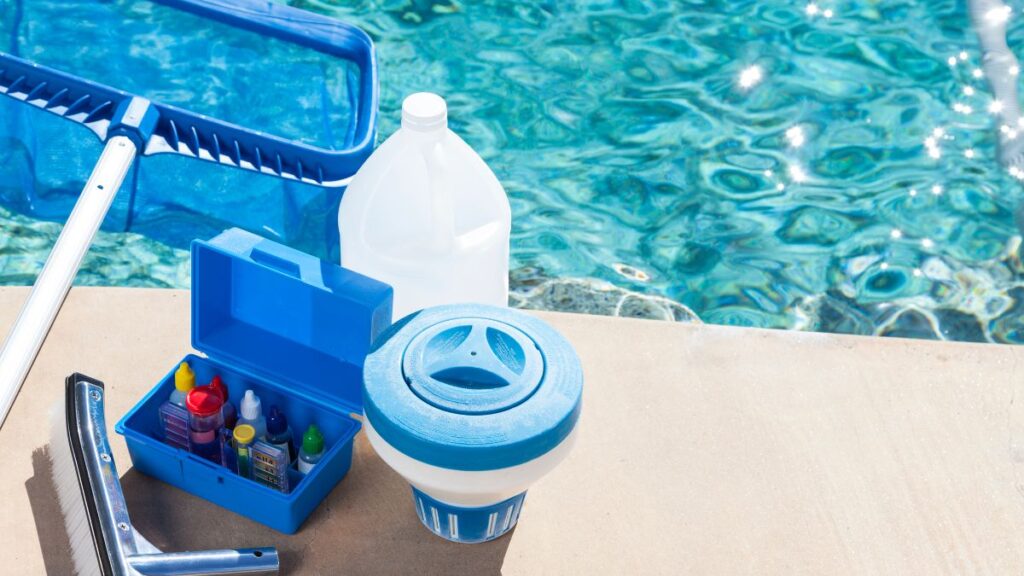
Preventing Stains and Damage: Proactive Pool Liner Care
The best way to deal with pool liner stains and damage is to stop them from happening in the first place. Here are some tips to help you keep your pool liner in top shape.
Regular Maintenance is Key
Consistency is your best friend when it comes to pool liner care. Regular maintenance can help prevent issues before they become problems. Here are some tips:
- Brush and Vacuum Regularly: As part of your pool liner maintenance routine, brush and vacuum your pool liner at least once a week. This helps remove dirt and prevent algae buildup on pool liners.
- Check for Damage: Regularly inspect your pool liner for signs of wear and tear. Small issues can become big problems if left unattended. Early detection can save you time and money in the long run.
- Monitor Water Levels: Maintaining the correct water level in your pool can help prevent undue stress on your liner. Too much or too little water can lead to liner stretching or wrinkling.
Gentle Cleaning to Prevent Damage
Your pool liner is tough, but it’s not invincible. Using harsh cleaning tools or chemicals can cause damage. Here’s how to clean your pool liner gently:
- Use the Right Tools: Opt for a soft pool liner brush and avoid brushes with hard, metal bristles. When vacuuming, ensure the vacuum head is suitable for pool liners.
- Choose Safe Cleaners: Whether using natural cleaners like vinegar and baking soda or opting for chemical cleaners, make sure they’re safe for your type of pool liner. Avoid cleaners with harsh abrasives or acids.
The Role of Pool Chemistry
Maintaining the right pool chemistry is crucial in preventing stains on your pool surface. Imbalanced pool water can lead to discoloration and scaling. Here’s what you need to know:
- Test Regularly: Use a pool water test kit to check pH, alkalinity, and sanitizer levels. This helps to ensure your pool water is balanced and safe.
- Adjust as Needed: If your pool water is imbalanced, use the appropriate chemicals to adjust the levels. Always follow the manufacturer’s instructions.
- Consider a pool water Clarifier: If your pool water is consistently cloudy, a pool water clarifier can help. It works by clumping tiny particles together so they can be filtered out.
Frequently Asked Questions: Your Pool Liner Queries Answered
What is the best way to clean a vinyl pool liner?
Vinyl pool liner cleaning requires a gentle touch. Start by brushing the liner with a soft pool brush to loosen dirt and algae. Then, wipe the liner with a clean cloth. Vacuum the pool to remove any dislodged debris. A mixture of water and vinegar or a pool liner cleaner can be used for stubborn stains. Always test a small area first when using any new cleaning product.
What do I use to clean my pool liner?
The tools you’ll need for pool liner cleaning include a soft pool brush, a clean cloth, a pool vacuum, and a cleaning solution. The cleaning solution can be a homemade mixture of water and vinegar, baking soda, or a commercial pool liner cleaner. Always ensure the cleaner is safe for your type of pool liner.
How do I get brown algae stains off my pool liner?
Brown algae stains can be a nuisance. Start by brushing the pool liner to loosen the algae. Then, vacuum the pool to remove the dislodged algae. If the stains persist, a pool liner cleaner or baking soda and water paste can be used. Remember to adjust your pool chemistry to prevent future algae growth.
How do I clean the ring around my pool liner?
The ring around your pool liner, often caused by oil and dirt, can be cleaned using a pool liner cleaner or a mixture of vinegar and water. Apply the cleaner to a sponge or cloth and gently scrub the ring. Rinely thoroughly afterward. Regular brushing and maintenance can help prevent the formation of a ring.



